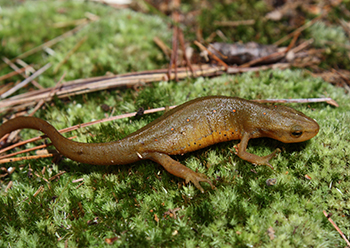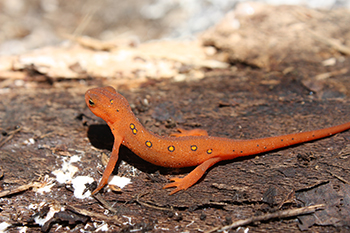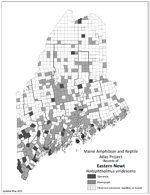Home → Fish & Wildlife → Wildlife → Species Information → Reptiles & Amphibians → Eastern Newt
Eastern Newt
Notophthalmus viridescens
On this page:

Photo: Trevor Persons
Distinguishing Characteristics

Photo: Trevor Persons
- Three distinct life stages: Larvae are aquatic, intermediate “eft” (juvenile phase) is terrestrial, and adult is aquatic
- Aquatic adult stage: olive green, greenish brown, or yellowish brown above, with numerous small black spots and two rows of larger red spots outlined in black; belly yellow. Smooth skin, tail keeled above and below
- Eft (juvenile) stage: red, reddish-brown, or reddish orange, with small black spots and larger red spots as adults. Skin dry and rough, thin bony tail.
Status and Distribution in Maine
- Common and secure
- Statewide
Habitat
- Adults: streams, lakes, and relatively permanent ponds in forested areas or agricultural landscapes
- Efts (juveniles): forested upland areas, often nearby adult habitat. Found under logs, rocks, decaying wood, or debris piles
Diet
- Adults and efts both carnivorous, eat insects, worms, leeches, small fishes, and eggs and larvae of spring-breeding salamanders and frogs
Seasonal Changes
- Adults overwinter in ponds and may be active year-round or may leave ponds to hibernate underground on land; efts probably hibernate underground in forests.
Natural History Notes
- Breed in water during spring, aquatic eggs are attached to vegetation
- Some newts skip the eft stage, and transition from larvae directly to gilled adults.
Share Your Sighting
There is much still to learn about the distribution and ecology of Maine’s herpetofauna, and we encourage members of the public to share their photo-documented observations as part of the Maine Amphibian & Reptile Atlas Project (MARAP).
To see if a township still needs documentation of a species, consult this distribution map (PDF). If a township lacks a photo or specimen record, we want your observation!
There are two ways to share your observations:
Submit your reptile or amphibian observation online
No service? No problem. Click here to download the survey to your device while connected, then take offline to collect observations from anywhere. Tip: The survey works best on Google Chrome and Safari.
Or upload sightings to the iNaturalist citizen science project through their website at iNaturalist.org or mobile app.
- When submitting an observation through iNaturalist add a description of the location (and other noteworthy information) to the “notes” field. This serves as a check on the locations automatically generated by smartphone cameras, which may be imprecise if cell service or GPS coverage is weak.
Thank you for doing your part to help conserve Maine’s reptiles and amphibians.
